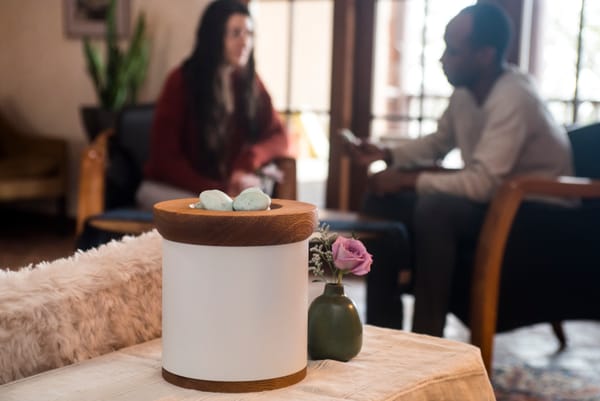Family Memorial Planning: Including Everyone in Decisions
Family memorial planning guide for including everyone in decisions. Navigate family dynamics and create consensus for meaningful memorial choices.

Your sister wants a traditional service. Your brother prefers something intimate. Your father's partner has ideas that clash with long-held family traditions. Meanwhile, you are holding the phone, trying to coordinate time zones, navigate decades of family history, and honor someone you all loved in different ways.
Family memorial planning brings together people who may rarely communicate, each carrying their own grief, their own memories, and their own vision of what would be meaningful. You may be feeling the weight of wanting everyone to feel heard while also fearing that too many voices will create conflict instead of consensus. This tension between inclusion and unity is real, and it is one of the most challenging aspects of planning a memorial, whether it occurs after death or during planning.
This guide offers practical frameworks for navigating family dynamics during memorial decision-making. These are not idealized solutions but concrete strategies that acknowledge the complexity of real families facing real grief.
Key Takeaways
- Family memorial planning requires intentional communication frameworks that validate each person's grief experience while working toward shared decisions.
- Three decision-making models (consensus, consultation, and consent-based) serve different family dynamics and decision types.
- Every day, tensions around religious differences, budget constraints, and geographic distance can be navigated with specific facilitation strategies.
- Physical memorial options that allow sharing, such as solidified remains, address coordination challenges by giving each family member a tangible connection.
- Successful family memorial planning strikes a balance between emotional validation and practical delegation systems, as well as clear communication timelines.
Reflections on love, loss, and the ways we carry them.
When a family loses someone, grief doesn’t arrive alone—it often brings with it the unfinished stories and quiet tensions that live beneath the surface. In my years of working with bereaved families, I’ve seen how memorial planning can unearth both tenderness and turmoil. What begins as a discussion about flowers or music can open the floodgates of decades-old sibling rivalries or unspoken hurt. Yet, when handled with care, the process can also become an act of healing.
I remember one family who came to me after their mother’s passing. The siblings hadn’t been in the same room for years. They disagreed about everything—where to hold the service, what to do with her ashes, even which hymns to sing. We began by setting gentle ground rules: each person would have space to speak without interruption. Over time, they discovered shared memories that softened their edges. By the end, they chose to transform their mother’s ashes into smooth stones through the Parting Stone process—each sibling keeping a few to place in gardens, beaches, and bookshelves across the world. It was a beautiful metaphor: wholeness restored not through division, but through sharing.
Memorial planning invites us to see that being heard is not the same as getting our way. When we release the need for perfect harmony, we create space for compassion to take root. As grief counselor and writer, I often remind families: these moments are not just about logistics, but legacy. The way we listen to one another while remembering the one we’ve lost becomes, in itself, a quiet memorial: one built not of stone or ceremony, but of grace.
Cathy Sanchez Babao
Parting Stone Grief Coach
Understanding Family Dynamics in Memorial Planning
When death occurs, family systems activate in ways that can be both beautiful and complicated. You may be navigating relationships that were already strained, or you might be surprised by unexpected tensions emerging among people who usually get along well.
Psychological research on grief indicates that memorial planning serves functions beyond the practical. It provides structure during chaos, creates opportunities for meaning-making, and allows family members to express care through action when words feel inadequate. When families plan together, they often report feeling more connected to both the deceased and to one another, even when the process itself is challenging.
Yet common dynamics emerge that can make inclusive planning challenging. Sibling rivalries that seemed resolved can resurface when making decisions about a parent's memorial. Generational differences between adult children and aging parents create different expectations about tradition and ritual. Estranged family members may want involvement that others resist. Blended families and chosen families introduce additional complexity regarding who has the right to participate in decision-making.
It is natural to feel tension when coordinating with family. Many families find that memorial planning amplifies existing communication patterns, both healthy and dysfunctional. Recognizing these patterns without judgment is the first step toward working with your family's reality rather than against it.
How do you include family members in memorial planning decisions?
Include family members by establishing a clear communication framework early, identifying who should have input versus decision-making authority, creating space for each person to share their perspective without immediate judgment, using structured facilitation methods like round-robin sharing, and documenting agreements as you go to prevent misunderstandings.
The goal is not perfect harmony but rather a process where each person feels their voice mattered, even if their specific preferences are not ultimately chosen. This requires distinguishing between being heard and getting your way, and helping family members understand that these are different outcomes. Some families find it helpful to establish that everyone will have the opportunity to speak, but not everyone will have veto power over final decisions.
When you approach family memorial planning with realistic expectations, you create space for both difficult emotions and meaningful collaboration. The process itself becomes an integral part of how your family copes with grief together.
Pre-Planning Communication Framework
Before discussing specific memorial decisions, you need a structure for how your family will communicate throughout this process. Many conflicts arise not from fundamental disagreements but from unclear expectations about who has authority to decide what, and how input will be gathered and considered.
Start by identifying who needs to be involved in conversations. This includes immediate family members, but you might also consider close friends who were like family, or family members who were estranged but may want some involvement. Different people may have various levels of decision-making authority versus consultation. The person handling estate matters might have legal authority, while others provide input that should be seriously considered but is not binding.
When initiating the first conversation, timing matters. If possible, have this conversation during a calm moment rather than in the immediate aftermath of death when emotions are most acute. For families doing planning, having these conversations when the person is still alive can reduce later conflict, though this requires the dying person's willingness to engage in these discussions.
Set shared objectives before diving into specific decisions. You might agree that the memorial should reflect the deceased's values, accommodate family members' travel needs, and stay within a particular budget. Having these overarching principles established helps when later decisions feel contentious. You can return to shared objectives and ask, "Which option best serves what we all agreed mattered most?"
For distributed families, documentation becomes critical. Some families create shared documents where proposals are posted, family members add comments, and decisions are recorded. This prevents the common problem of "I thought we decided something else" weeks later. Video calls enable richer communication than email or text, particularly when discussing emotional topics where tone is crucial.
| Communication Method | Best For | Limitations | When to Use |
|---|---|---|---|
| Synchronous (Video Calls, Phone, In-Person) | Complex decisions requiring discussion, addressing conflicts, emotional processing together | Requires coordinating schedules across time zones, can be exhausting for some family members | Major decisions like service format, handling of remains, budget allocation |
| Asynchronous (Email, Shared Docs, Group Texts) | Information sharing, gathering input from many people, allowing time for reflection | Lacks emotional nuance, can lead to misunderstandings, slower for urgent decisions | Collecting preferences, sharing updates, documenting agreements, coordinating logistics |
Create a communication rhythm that your family can rely on. Some families benefit from scheduled check-in calls every few days during the active planning phase. Others prefer a primary coordinator who gathers input individually and then shares summaries with the group. Match your approach to your family's communication strengths and weaknesses.
The pre-planning framework you establish sets the tone for everything that follows. When family members know how their input will be gathered, who will make final decisions, and how disagreements will be handled, they are more likely to engage constructively rather than defensively.
Decision-Making Models for Memorial Planning
Not all memorial decisions require the same level of agreement. Understanding different decision-making models helps you match the right approach to each type of decision your family faces.
Consensus-based decision-making means everyone affected must agree before moving forward. This model works well for decisions with profound symbolic significance or when you genuinely need everyone's buy-in for the decision to feel meaningful. For example, deciding whether to scatter remains in a meaningful location might warrant consensus if multiple family members will participate in the scattering. The strength of consensus is that it ensures no one feels overridden on matters of profound importance. The challenge is that it can be time-consuming and may lead to paralysis if family members have truly incompatible preferences.
Consultation-based decision-making involves gathering input from everyone, but designates specific individuals to make the final decision. This model balances inclusion with efficiency. You might consult all siblings about the memorial service format, but assign the oldest sibling and the deceased's partner to make the final call. Consultation acknowledges that people deserve to be heard without requiring unanimous agreement. It works well for most memorial planning decisions where you want family input but need someone to make the ultimately decision. The key is being clear upfront about who has final decision authority, so people do not mistake consultation for consensus.
Consent-based decision-making asks whether anyone has a principled objection that would cause harm if ignored, rather than whether everyone enthusiastically agrees. This model is useful when you need to move forward but want to ensure that a decision does not cause significant harm to anyone. For instance, if someone has religious objections to a proposed memorial format, that would constitute a principled objection. Preferring a different date or time would not. Consent-based approaches help distinguish between preferences and non-negotiable needs.
When facilitating family conversations, specific techniques help ensure everyone's voice is heard:
Round-robin input means going around the group systematically so everyone speaks before anyone speaks twice. This prevents dominant personalities from monopolizing the conversation and ensures quieter family members have space to contribute.
Silent brainstorming involves everyone writing down their ideas independently before discussion begins. This prevents early suggestions from anchoring everyone's thinking and allows for more diverse ideas to emerge. You might ask everyone to write down three things that would make the memorial meaningful to them, then share all ideas without initial judgment.
Designated facilitation means that someone holds the explicit role of keeping the conversation on track, noticing who has not spoken, and redirecting when the discussion becomes unproductive.
Real-world application matters more than theoretical models. Consider the following scenario: Your family must decide between a formal funeral service and an informal memorial gathering. Using a consultation model, you might gather input through a family video call where everyone shares what type of gathering would feel most meaningful to them. The designated decision-maker, typically the deceased's spouse, listens carefully and then makes a decision, explaining their reasoning in terms of what they believe the deceased would have wanted and which option best serves the family's shared objectives.
Or imagine budget discussions where consensus feels impossible because people have wildly different financial resources. A consent-based approach would identify the actual budget constraint, then ask whether any proposed expenditure would cause genuine financial hardship to someone expected to contribute. This shifts the conversation from "what I prefer" to "what is workable for everyone involved."
The decision-making model you choose should match your family's needs and the specific decision at hand. Being explicit about which model you are using prevents confusion and helps people engage appropriately.
Navigating Common Points of Tension
Specific friction points emerge predictably during family memorial planning. Understanding these patterns helps you prepare for and navigate them with greater skill.
Religious and cultural differences within families create some of the most emotionally charged tensions. When adult children practice a different faith from their parents, or when a deceased person moved away from their family's religious traditions, questions arise about which practices should be honored. One sibling might want a Catholic mass while another insists their parent was no longer practicing Catholic and would have preferred something secular. Blended families may bring together different cultural traditions around death and memorialization.

The reframe here is recognizing that multiple truths can coexist. The deceased may have held complex, even contradictory, relationships with religion over their lifetime. Rather than determining the "correct" interpretation of their beliefs, some families find it helpful to create space for multiple expressions of their beliefs. This might look like a memorial service with both religious and secular elements, or acknowledging in the service program that different family members understood the deceased's spiritual life differently, and that this diversity itself reflects the complexity of a whole human life.
Specific strategies include consulting with religious leaders who specialize in interfaith services, creating distinct memorial moments that cater to different needs (such as a religious funeral followed by a secular celebration of life), or allowing various family members to contribute elements that reflect their own unique relationships with the deceased, rather than prescribing a single unified approach.
Budget disagreements surface tension around money but often reflect deeper issues about respect, fairness, and what expenditure signifies about love. One family member might feel that an expensive memorial demonstrates proper honor, while another believes simplicity better reflects the deceased's values. Some family members have significantly greater financial resources than others, creating awkwardness about who pays for what.
Reframe budget conversations as resource allocation decisions rather than demonstrations of love. The question shifts from "how much should we spend" to "how should we allocate our limited resources to create the most meaningful memorial experience." This opens space for creativity rather than just escalating expenditure.
Strategies include establishing the total available budget early and letting that constraint guide decisions, separating one-time memorial costs from ongoing memorial practices that require no significant expenditure, and having frank conversations about who can contribute what financially without shame or pressure. Some families find it helpful to separate memorial service costs from cremation handling costs and ongoing memorial practices, allowing different people to contribute to various aspects according to their means and interests.
Geographic distribution challenges mean that family members scattered across time zones and regions must coordinate despite practical barriers. Someone must decide whether to delay a memorial service to accommodate distant family travel or proceed more quickly to meet other family members' grief needs. Virtual attendance options have become increasingly common, but they also create their own dynamics regarding who participates in person versus remotely.

The reframe acknowledges that there may not be a perfect solution, and that prioritizing the attendance of some people necessarily means others face greater challenges. The goal is to make deliberate choices rather than default to whatever is convenient for the geographically closest family members.
Strategies include considering multiple memorial events in different locations, rather than one that requires extensive travel for most people. Additionally, utilizing technology to allow for meaningful remote participation, rather than treating it as second-class attendance, is also important. Recording services should be provided for people who cannot attend in real-time, and shipping physical memorial items to distant family members is also a valuable option. Hence, they have tangible connections even if they could not participate in person.
Estranged family member inclusion or exclusion raises questions about whether and how to involve people whose relationships with the deceased or with other family members were complicated. An estranged parent might want involvement in planning their child's memorial over the objections of the deceased's partner and friends. Adult children might disagree about whether to inform or include an estranged sibling.
Reframe these questions by distinguishing between someone's right to grieve and their right to participate in the planning process. Most people acknowledge that even estranged family members experience grief. The question is whether they should help plan, attend, or be given information about memorial plans. These are separate decisions requiring different considerations.
Strategies include designating boundaries around who has planning input while allowing broader attendance at memorial services, considering the deceased's expressed wishes about these relationships if known, creating separate, smaller gatherings that will enable different relationship circles to grieve without forced interaction, and sometimes accepting that not every family member will attend the same memorial event.
Each point of tension benefits from naming the underlying concern, reframing it more productively, and implementing specific strategies rather than relying on goodwill alone to resolve the tension.
Physical Memorial Options That Support Family Inclusion
The physical form that remains after cremation significantly impacts how families can interact with their loved one's memory. Traditional cremated remains create practical challenges for families who want to share without the literal division of remains that can feel uncomfortable or incomplete.
Some families choose to divide cremated remains among multiple urns, allowing each person or family unit to have remains. However, this often feels unsatisfactory. Many people report that having "some" of the remains feels different than having a complete memorial, and the act of dividing can feel like fragmenting the person rather than sharing them.

Memorial jewelry and keepsake urns address this by using small amounts of remains in different items. Each family member may receive a pendant or small vessel containing a portion of their loved one's remains. This allows sharing but leaves the vast majority of remains unaddressed. Families still face the question of what to do with the remaining cremated remains after creating keepsakes.
Scattering in multiple meaningful locations enables different family members to participate in memorial acts at places that held significance for the deceased. Some families scatter portions at other sites, creating ongoing opportunities for monuments. This works well when the deceased expressed wishes about scattering and when family members are comfortable with this form of disposition. However, scattering is final, and some family members may want something tangible to hold onto.
Solidified remains represent a different approach that explicitly addresses family sharing challenges. Parting Stone transforms cremated remains into a collection of smooth, solid stones that can be held, shared, and cherished. The process returns the full amount of remains in solid form, creating 40-80 individual stones from a complete set of cremated remains.
This format solves several coordination challenges that distributed families face. Each family member can receive stones without the sense of incompleteness that comes from dividing ashes. Geographic distance becomes less of a barrier because rocks can be easily shipped or transported without the anxiety that surrounds traveling with cremated remains.
One Parting Stone customer shared: "Thank you for taking care of my FIL's ashes. The stones will allow my MIL and their grandkids to spread them at all their favorite locations ,including on our family vacation to WDW. They all get to keep a piece of him with them."
Another family described their experience: "We saved my mother's cremated remains for years so that they could be mixed with my dads upon his passing and they could be 'bound together' even in death. My parents loved to travel, so we take our stones with us on vacations and leave them in oceans, lakes, forests and gardens. We even mixed some into our landscaping. On the first anniversary, my sisters and I painted some of our stones with pictures and uplifting messages. This practice brings us a sense of peace and comfort and keeps my parents' memory close throughout the years."
The shareability of solidified remains means that family memorial decisions become less zero-sum. Rather than arguing about whether to scatter, bury, or keep remains because you can only choose one, families can do multiple things. Some stones might be placed in a memorial garden, others kept by different family members, and others scattered in meaningful locations over time. This flexibility can reduce conflict during memorial planning because you are not forced into a single irrevocable choice.
For families navigating memorial family planning, solidified remains cost $2,495 for human remains solidification, with the process taking 8-10 weeks. This timeline should be factored into memorial planning decisions, particularly if you wish for the solidified remains to be present at a memorial service.
The physical form of remains is not just a practical consideration but can actively support or complicate your family's ability to include everyone meaningfully in memorial practices. When considering options, ask yourself whether the format creates opportunities for sharing or requires you to choose between family members' needs and preferences.

Creating Your Family Memorial Planning Checklist
Having frameworks is helpful, but you also need concrete next steps to follow. This checklist organizes family memorial planning into manageable phases.
Immediate Decisions (First 72 Hours):
- Identify the primary decision-maker(s) and their authority scope
- Determine who needs to be informed immediately about the death
- Decide on immediate disposition needs (burial, cremation, body donation)
- Establish primary communication channel for family updates
- Assign one person as communication coordinator to prevent information chaos
Weeks 1-2: Foundation Setting
- Schedule initial family meeting (virtual or in-person) for memorial planning discussion
- Establish decision-making models for different types of decisions
- Set overall budget parameters and determine who can contribute what
- Identify any time-sensitive constraints (religious requirements, travel considerations, venue availability)
- Gather the deceased's expressed wishes if documented anywhere
- Begin compiling list of people to be invited to memorial service
- Research and contact necessary service providers (funeral homes, celebrants, venues)
Weeks 2-4: Detail Planning
- Make service format decisions (formal, informal, religious, secular, hybrid)
- Determine date, time, and location that accommodates priority attendees
- Decide on remains handling (burial, scattering, keeping, solidification, or combination)
- Assign specific roles and responsibilities using delegation matrix
- Plan service elements (who speaks, what readings or music, what rituals)
- Coordinate practical logistics (catering, accommodation for traveling family, technology for remote attendance)
- Create service program and any printed materials
- Finalize attendee list and send invitations
Delegation Matrix:
Rather than one person managing everything, distribute responsibilities based on people's strengths and capacity. Create a simple chart listing:
- Task description
- Person responsible
- Deadline
- Communication requirements (who needs updates as task progresses)
Some family members might handle emotional labor like contacting distant relatives and coordinating speakers. Others might manage practical logistics like venue coordination and catering. Still others might focus on creative elements like photo displays or memorial websites. Matching tasks to people's capabilities and current bandwidth reduces overwhelm and prevents bottlenecks.
Communication Cadence Recommendations:
During active planning, have scheduled check-ins rather than relying on ad-hoc updates. This might look like:
- Brief daily email updates from the coordinator with any new information or decisions made
- Twice-weekly video calls for family members directly involved in planning
- One comprehensive update weekly to the broader family circle who should be informed but are not actively planning
This rhythm keeps people informed without creating communication overload. It also establishes predictability so family members know when to expect updates rather than feeling anxious about being left out of the loop.
Conflict Resolution Escalation Path:
Despite best efforts, conflicts will likely emerge. Rather than hoping conflicts resolve themselves, establish ahead of time how disagreements will be handled:
- Initial attempt: The people directly in conflict discuss privately to seek understanding
- If unresolved: Bring concern to the primary decision-maker(s) for input
- If still stuck: Involve a neutral facilitator (family friend, religious leader, grief counselor) who can help mediate
- If fundamental impasse: Accept that some family members may need to create separate memorial opportunities rather than forcing unified participation
Having this path identified prevents conflicts from derailing the entire memorial planning process. It acknowledges that perfect consensus may not be possible and provides alternatives when it is not.
Conclusion
Family memorial planning requires you to coordinate across relationships, navigate grief while making practical decisions, and honor someone's memory in ways that feel meaningful to individuals with diverse needs and perspectives. This is genuinely difficult work, and doing it imperfectly does not mean you have failed.
The frameworks offered here provide a structure for inclusive memorial planning, from understanding family dynamics to selecting appropriate decision-making models and navigating predictable tensions. The goal throughout is not to eliminate difficulty, but rather to create processes where difficulty can be metabolized into meaningful, memorable experiences that serve your family's healing.
Remember that memorial planning evolves. The decisions you make in the immediate aftermath of death are not your only opportunity to honor your loved one. Some families find that their initial memorial plans shift as grief progresses and different needs emerge. This is normal and healthy. Permit yourself to adjust rather than feeling locked into initial decisions.
If physical shareability would ease your family's coordination by allowing each person to have a tangible memorial connection, consider exploring solidified remains options that transform cremated remains into a form designed for distribution among family members. When the physical format supports sharing rather than forcing division, some of the zero-sum conflicts around memorial decisions become less acute.
Your family's memorial planning journey is unique. These tools exist to serve you, not to prescribe what your process "should" look like. Use what helps, adapt what needs adjustment, and trust that your intention to include everyone meaningfully in decisions honors both the deceased and the family they loved.
Frequently Asked Questions
How do you handle disagreements between family members about memorial plans?
Handle disagreements by first acknowledging each person's perspective without judgment, identifying whether the conflict is about preferences versus non-negotiable needs, clarifying who has final decision-making authority for this specific decision, and considering whether multiple memorial events or elements can accommodate different needs rather than forcing a single approach that everyone must accept.
Should estranged family members be included in memorial planning?
Estranged family members' inclusion depends on the deceased's expressed wishes if known, the nature and reason for estrangement, whether their involvement would cause significant distress to other key family members, and distinguishing between their right to grieve (which exists regardless) and their right to participate in planning decisions (which may be limited). Some families allow attendance at memorial services while excluding estranged members from planning discussions.
How do you coordinate memorial planning when family lives in different states or countries?
Coordinate across distances by establishing one primary communication platform everyone checks regularly, scheduling video calls during overlapping waking hours across time zones, documenting all decisions in shared written format to prevent miscommunication, considering multiple memorial events in different locations rather than requiring extensive travel, and using technology to allow meaningful remote participation in primary memorial services rather than treating virtual attendance as inferior.
What if family members have different religious or cultural expectations for the memorial?
Address different religious expectations by acknowledging that the deceased may have held complex relationships with faith traditions over their lifetime, creating space for multiple expressions through different service elements or separate memorial moments, consulting with religious leaders experienced in interfaith or multicultural services, and focusing on what unites the family in grief rather than requiring unanimous agreement on spiritual interpretation.
How do you divide cremated remains among family members who all want to keep some?
Divide cremated remains by using multiple urns or keepsake vessels, creating memorial jewelry that contains small amounts of remains, considering solidified remains services that transform cremated remains into shareable solid stones, scattering in multiple meaningful locations with different family members participating, or combining approaches where some remains are shared in tangible form while others are scattered or buried.
How long should you wait to hold a memorial service to accommodate distant family travel?
Timing memorial services involves balancing immediate family members' grief needs for timely closure against distant relatives' ability to travel, considering whether to hold multiple memorial events rather than one that requires extensive travel, using virtual attendance options to include people who cannot travel quickly, and recognizing that there may be no perfect timing that works equally well for everyone involved.
What if the deceased did not leave clear wishes about their memorial?
When wishes are unclear, family members can base decisions on what they knew of the deceased's values and preferences even if not explicitly stated, prioritize creating meaningful experiences for the grieving family rather than trying to guess perfectly, involve people who knew the deceased well from different life periods, and accept that some uncertainty is normal and does not prevent creating a memorial that honors their memory meaningfully.
How do you involve children in family memorial planning decisions?
Involve children by offering age-appropriate participation options rather than full planning authority, asking what would help them feel connected to the deceased rather than overwhelming them with decisions, protecting them from adult conflicts about planning while still honoring their grief, allowing them to contribute creative elements like drawings or letters, and consulting child development or grief counseling resources for guidance on developmentally appropriate involvement.
References
American Psychological Association. (2023). Grief: Coping with the loss of your loved one. https://www.apa.org/topics/grief
Doka, K. J. (Ed.). (2002). Disenfranchised grief: New directions, challenges, and strategies for practice. Research Press. https://www.researchpress.com
Family Caregiver Alliance. (2024). Grief and loss. https://www.caregiver.org/resource/grief-and-loss/
National Alliance for Grieving Children. (2024). Supporting grieving children and families. https://childrengrieve.org
National Funeral Directors Association. (2024). Planning a funeral or memorial service. https://www.nfda.org/planning-a-funeral
Wolfelt, A. D. (2004). The understanding your grief support group guide. Companion Press. https://www.centerforloss.com










